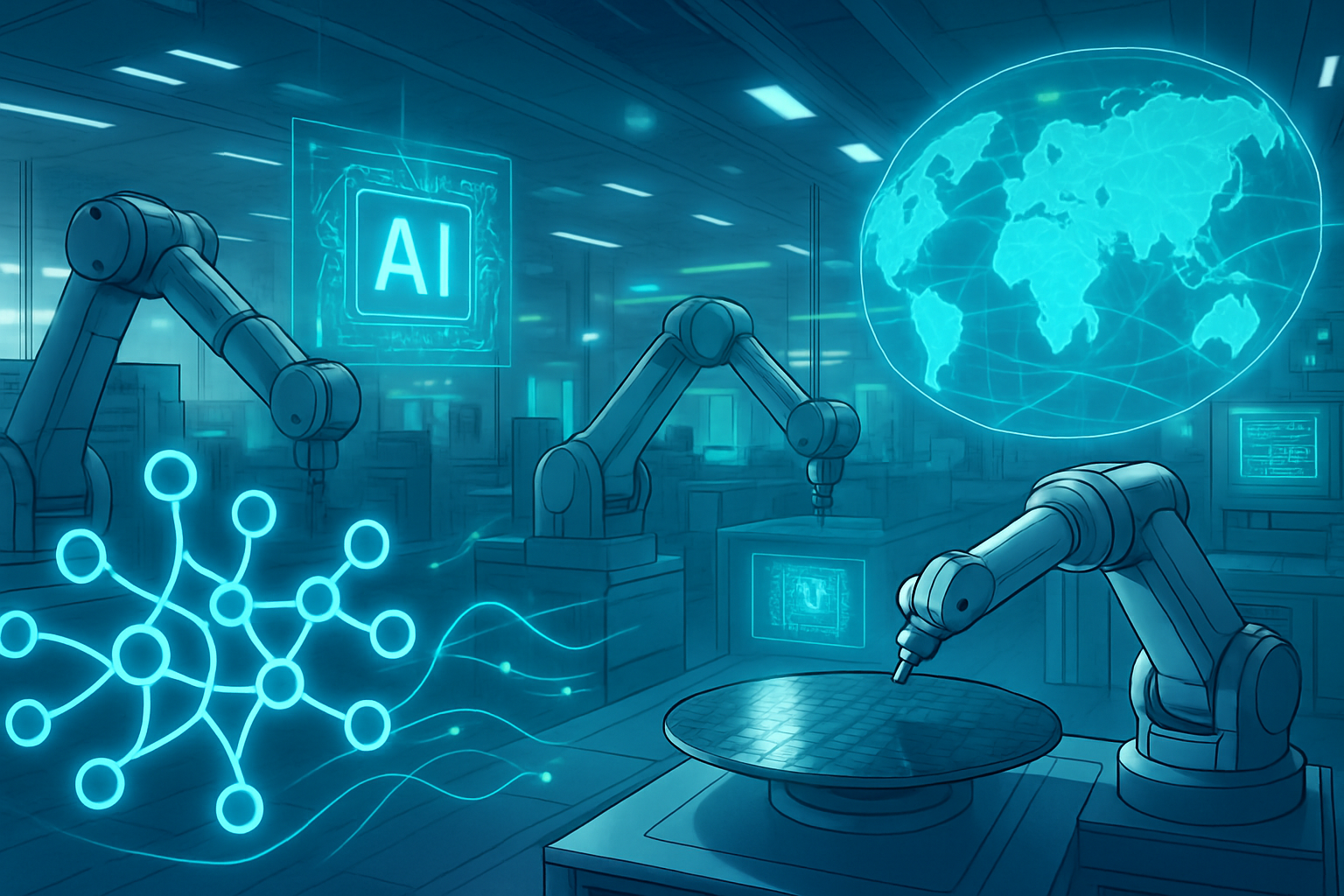November 7, 2025 – The global technological landscape is being irrevocably reshaped by an escalating, high-stakes competition between the United States and China for dominance in the semiconductor industry. This intense rivalry, now reaching a critical juncture in late 2025, has profound and immediate implications for the future of artificial intelligence development and global technological supremacy. As both nations double down on strategic industrial policies—the US with stringent export controls and China with aggressive self-sufficiency drives—the world is witnessing the rapid formation of a "silicon curtain" that threatens to bifurcate the global AI ecosystem.
The current state of play is characterized by a tit-for-tat escalation of restrictions and countermeasures. The United States is actively working to choke off China's access to advanced semiconductor technology, particularly those crucial for training and deploying cutting-edge AI models. In response, Beijing is pouring colossal investments into its domestic chip industry, aiming for complete independence from foreign technology. This geopolitical chess match is not merely about microchips; it's a battle for the very foundation of future innovation, economic power, and national security, with AI at its core.
The Technical Crucible: Export Controls, Indigenous Innovation, and the Quest for Advanced Nodes
The technical battleground in the US-China semiconductor race is defined by control over advanced chip manufacturing processes and the specialized equipment required to produce them. The United States has progressively tightened its grip on technology exports, culminating in significant restrictions around November 2025. The White House has explicitly blocked American chip giant NVIDIA (NASDAQ: NVDA) from selling its latest cutting-edge Blackwell series AI chips, including even scaled-down variants like the B30A, to the Chinese market. This move, reported by The Information, specifically targets chips essential for training large language models, reinforcing the US's determination to impede China's advanced AI capabilities. These restrictions build upon earlier measures from October 2023 and December 2024, which curtailed exports of advanced computing chips and chip-making equipment capable of producing 7-nanometer (nm) or smaller nodes, and added numerous Chinese entities to the Entity List. The US has also advised government agencies to block sales of reconfigured AI accelerator chips to China, closing potential loopholes.
In stark contrast, China is aggressively pursuing self-sufficiency. Its largest foundry, Semiconductor Manufacturing International Corporation (SMIC), has made notable progress, achieving milestones in 7nm chip production. This has been accomplished by leveraging deep ultraviolet (DUV) lithography, a generation older than the most advanced extreme ultraviolet (EUV) machines, access to which is largely restricted by Western allies like the Netherlands (home to ASML Holding N.V. (NASDAQ: ASML)). This ingenuity allows Chinese firms like Huawei Technologies Co., Ltd. to scale their Ascend series chips for AI inference tasks. For instance, the Huawei Ascend 910C is reportedly demonstrating performance nearing that of NVIDIA's H100 for AI inference, with plans to produce 1.4 million units by December 2025. SMIC is projected to expand its advanced node capacity to nearly 50,000 wafers per month by the end of 2025.
This current scenario differs significantly from previous tech rivalries. Historically, technological competition often involved a race to innovate and capture market share. Today, it's increasingly defined by strategic denial and forced decoupling. The US CHIPS and Science Act, allocating substantial federal subsidies and tax credits, aims to boost domestic chip production and R&D, having spurred over $540 billion in private investments across 28 states by July 2025. This initiative seeks to significantly increase the US share of global semiconductor production, reducing reliance on foreign manufacturing, particularly from Taiwan Semiconductor Manufacturing Company Limited (NYSE: TSM). Initial reactions from the AI research community and industry experts are mixed; while some acknowledge the national security imperatives, others express concern that overly aggressive controls could stifle global innovation and lead to a less efficient, fragmented technological landscape.
Corporate Crossroads: Navigating a Fragmented AI Landscape
The intensifying US-China semiconductor race is creating a seismic shift for AI companies, tech giants, and startups worldwide, forcing them to re-evaluate supply chains, market strategies, and R&D priorities. Companies like NVIDIA (NASDAQ: NVDA), a leader in AI accelerators, face significant headwinds. CEO Jensen Huang has openly acknowledged the severe impact of US restrictions, stating that the company now has "zero share in China's highly competitive market for datacenter compute" and is not actively discussing selling its advanced Blackwell AI chips to China. While NVIDIA had previously developed lower-performance variants like the H20 and B30A to comply with earlier export controls, even these have now been targeted, highlighting the tightening blockade. This situation compels NVIDIA to seek growth in other markets and diversify its product offerings, potentially accelerating its push into software and other AI services.
On the other side, Chinese tech giants like Huawei Technologies Co., Ltd. and their domestic chip partners, such as Semiconductor Manufacturing International Corporation (SMIC), stand to benefit from Beijing's aggressive self-sufficiency drive. In a significant move in early November 2025, the Chinese government announced guidelines mandating the exclusive use of domestically produced AI chips in new state-funded AI data centers. This retroactive policy requires data centers with less than 30% completion to replace foreign AI chips with Chinese alternatives and cancel any plans to purchase US-made chips. This effectively aims for 100% self-sufficiency in state-funded AI infrastructure, up from a previous requirement of at least 50%. This creates a guaranteed, massive domestic market for Chinese AI chip designers and manufacturers, fostering rapid growth and technological maturation within China's borders.
The competitive implications for major AI labs and tech companies are profound. US-based companies may find their market access to China—a vast and rapidly growing AI market—increasingly constrained, potentially impacting their revenue streams and R&D budgets. Conversely, Chinese AI startups and established players are being incentivized to innovate rapidly with domestic hardware, potentially creating unique AI architectures and software stacks optimized for their homegrown chips. This could lead to a bifurcation of AI development, where distinct ecosystems emerge, each with its own hardware, software, and talent pools. For companies like Intel (NASDAQ: INTC), which is heavily investing in foundry services and AI chip development, the geopolitical tensions present both challenges and opportunities: a chance to capture market share in a "friend-shored" supply chain but also the risk of alienating a significant portion of the global market. This market positioning demands strategic agility, with companies needing to navigate complex regulatory environments while maintaining technological leadership.
Broader Ripples: Decoupling, Supply Chains, and the AI Arms Race
The US-China semiconductor race is not merely a commercial or technological competition; it is a geopolitical struggle with far-reaching implications for the broader AI landscape and global trends. This escalating rivalry is accelerating a "decoupling" or "bifurcation" of the global technological ecosystem, leading to the potential emergence of two distinct AI development pathways and standards. One pathway, led by the US and its allies, would prioritize advanced Western technology and supply chains, while the other, led by China, would focus on indigenous innovation and self-sufficiency. This fragmentation could severely hinder global collaboration in AI research, limit interoperability, and potentially slow down the overall pace of AI advancement by duplicating efforts and creating incompatible systems.
The impacts extend deeply into global supply chains. The push for "friend-shoring" and domestic manufacturing, while aiming to bolster resilience and national security, introduces significant inefficiencies and higher production costs. The historical model of globally optimized, cost-effective supply chains is being fundamentally altered as nations prioritize technological sovereignty over purely economic efficiencies. This shift affects every stage of the semiconductor value chain, from raw materials (like gallium and germanium, on which China has imposed export controls) to design, manufacturing, and assembly. Potential concerns abound, including the risk of a full-blown "chip war" that could destabilize international trade, create economic friction, and even spill over into broader geopolitical conflicts.
Comparisons to previous AI milestones and breakthroughs highlight the unique nature of this challenge. Past AI advancements, such as the development of deep learning or the rise of large language models, were largely driven by open collaboration and the free flow of ideas and hardware. Today, the very foundational hardware for these advancements is becoming a tool of statecraft. Both the US and China view control over advanced AI chip design and production as a top national security priority and a determinant of global power, triggering what many are calling an "AI arms race." This struggle extends beyond military applications to economic leadership, innovation, and even the values underpinning the digital economy. The ideological divide is increasingly manifesting in technological policies, shaping the future of AI in ways that transcend purely scientific or commercial considerations.
The Road Ahead: Self-Sufficiency, Specialization, and Strategic Maneuvers
Looking ahead, the US-China semiconductor race promises continued dynamic shifts, marked by both nations intensifying their efforts in distinct directions. In the near term, we can expect China to further accelerate its drive for indigenous AI chip development and manufacturing. The recent mandate for exclusive use of domestic AI chips in state-funded data centers signals a clear strategic pivot towards 100% self-sufficiency in critical AI infrastructure. This will likely lead to rapid advancements in Chinese AI chip design, with a focus on optimizing performance for specific AI workloads and leveraging open-source AI frameworks to compensate for any lingering hardware limitations. Experts predict China's AI chip self-sufficiency rate will rise significantly by 2027, with some suggesting that China is only "nanoseconds" or "a mere split second" behind the US in AI, particularly in certain specialized domains.
On the US side, expected near-term developments include continued investment through the CHIPS Act, aiming to bring more advanced manufacturing capacity onshore or to allied nations. There will likely be ongoing efforts to refine export control regimes, closing loopholes and expanding the scope of restricted technologies to maintain a technological lead. The US will also focus on fostering innovation in AI software and algorithms, leveraging its existing strengths in these areas. Potential applications and use cases on the horizon will diverge: US-led AI development may continue to push the boundaries of foundational models and general-purpose AI, while China's AI development might see greater specialization in vertical domains, such as smart manufacturing, autonomous systems, and surveillance, tailored to its domestic hardware capabilities.
The primary challenges that need to be addressed include preventing a complete technological balkanization that could stifle global innovation and establishing clearer international norms for AI development and governance. Experts predict that the competition will intensify, with both nations seeking to build comprehensive, independent AI ecosystems. What will happen next is a continued "cat and mouse" game of technological advancement and restriction. The US will likely continue to target advanced manufacturing capabilities and cutting-edge design tools, while China will focus on mastering existing technologies and developing innovative workarounds. This strategic dance will define the global AI landscape for the foreseeable future, pushing both sides towards greater self-reliance while simultaneously creating complex interdependencies with other nations.
The Silicon Divide: A New Era for AI
The US-China semiconductor race represents a pivotal moment in AI history, fundamentally altering the trajectory of global technological development. The key takeaway is the acceleration of technological decoupling, creating a "silicon divide" that is forcing nations and companies to choose sides or build independent capabilities. This development is not merely a trade dispute; it's a strategic competition for the foundational technologies that will power the next generation of artificial intelligence, with profound implications for economic power, national security, and societal advancement. The significance of this development in AI history cannot be overstated, as it marks a departure from an era of relatively free global technological exchange towards one characterized by strategic competition and nationalistic industrial policies.
This escalating rivalry underscores AI's growing importance as a geopolitical tool. Control over advanced AI chips is now seen as synonymous with future global leadership, transforming the pursuit of AI supremacy into a zero-sum game for some. The long-term impact will likely be a more fragmented global AI ecosystem, potentially leading to divergent technological standards, reduced interoperability, and perhaps even different ethical frameworks for AI development in the East and West. While this could foster innovation within each bloc, it also carries the risk of slowing overall global progress and exacerbating international tensions.
In the coming weeks and months, the world will be watching for further refinements in export controls from the US, particularly regarding the types of AI chips and manufacturing equipment targeted. Simultaneously, observers will be closely monitoring the progress of China's domestic semiconductor industry, looking for signs of breakthroughs in advanced manufacturing nodes and the widespread deployment of indigenous AI chips in its data centers. The reactions of other major tech players, particularly those in Europe and Asia, and their strategic alignment in this intensifying competition will also be crucial indicators of the future direction of the global AI landscape.
This content is intended for informational purposes only and represents analysis of current AI developments.
TokenRing AI delivers enterprise-grade solutions for multi-agent AI workflow orchestration, AI-powered development tools, and seamless remote collaboration platforms.
For more information, visit https://www.tokenring.ai/.









